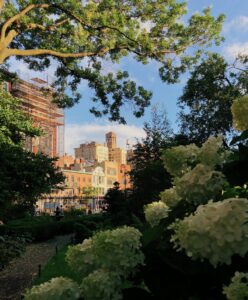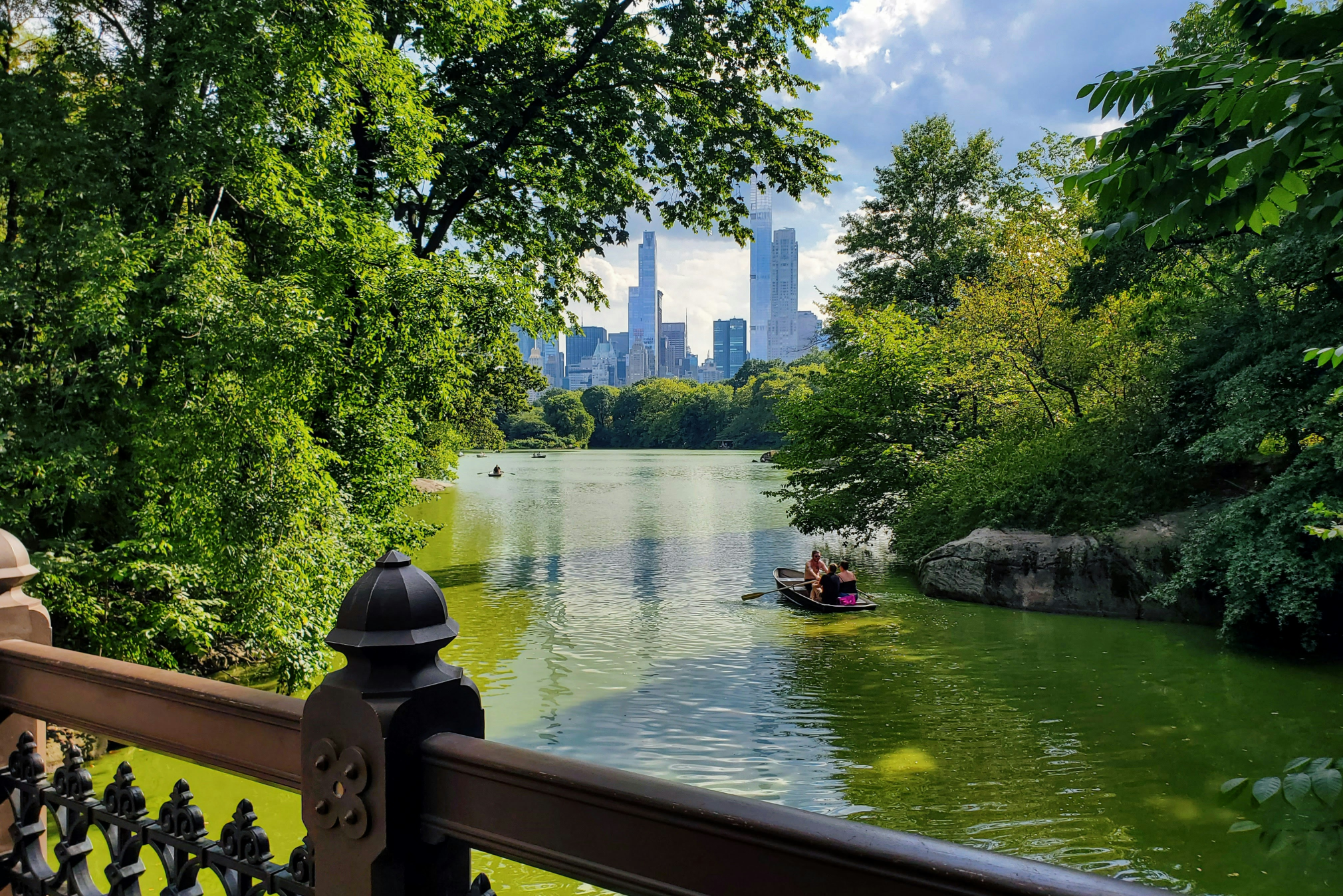Luminaries share how they connect with nature in New York.
What comes to mind when you think about “nature”? Often, cultural references emphasize the idea of a pristine landscape where humans are either absent or merely passing through. Especially for those who live in cities, this view of nature — as a place apart from the human realm — can obscure how deeply humans are linked to the natural world. In reality, our lives and well-being are intertwined with Earth’s ecosystems, and how humans think about our place in the natural world can inform our ability to understand and respond to environmental crises.
Planners and environmentalists have long understood the value of green spaces in cities, and as the climate changes, it is more important than ever that people consider nature in the city. Many cities make great efforts to create green spaces, but urban areas are also full of “unintentional nature” in overlooked or underdeveloped spaces. City leaders and advocates are increasingly pursuing opportunities to build more sustainable urban environments that make cities more liveable, resilient, and equitable. Urban biodiversity can improve pollination, air and water quality, and temperature regulation. Trees and green space can help warming cities stay cool. And access to nature has a measurable impact on human health, supporting mental and physical wellness — and even increasing feelings of belonging.
With summer approaching, the Luminary Labs team shared where they go to connect with nature in the city. This collectively sourced list includes parks, paths, and experiences to help you access your own natural experiences in New York or wherever you call home.
A city of parks
New York City maintains 1,700 parks and recreation centers across its five boroughs; they continue to shape the city’s landscape and enhance our quality of life.
According to Senior Associate Maeser Allen, the best way to encounter nature in the city is through long walks, often toward a green space or waterway. He often ends up in Riverside Park. Running from West 72nd Street to West 129th Street, Riverside’s many intersecting pathways traverse diverse terrain between Riverside Drive and the Hudson River. Maeser recommends entering the park at 84th Street, right alongside the massive outcropping of Manhattan schist called Mount Tom, named by Edgar Allan Poe and known to be one of his preferred writing spots. With sweeping views of the Hudson, “the park provides a prime sunset experience year-round.”
On the other side of Manhattan, you’ll find another waterfront park that Senior Talent Associate Olivia Anderle calls a “hidden gem” of the Upper East Side. Carl Schurz Park packs a lot into less than 15 acres, with lawns, dog runs, and athletic courts overlooking the East River. “I am continuously delighted by the serenity of the park, despite its many attractions … there are so many little nooks and alcoves to tuck away from any crowds,” says Olivia.
Prospect Park is a 526-acre oasis of green in Brooklyn, with plenty of hidden greens, water features, the Prospect Park Zoo, Brooklyn Botanical Gardens, and so much more. For Engagement Manager Natalia Allen, the park is the perfect place to explore and relax with friends. “Prospect Park has hosted many of my life events — my engagement, my wedding, a million celebrations (birthdays, end-of-year parties, going-away parties, Fourth of July picnics),” says Natalia. The park also holds the distinction as the site of Natalia’s first-ever broken bone, suffered while roller skating at the LeFrak Center.
Nature in plain sight
The parks and formal green spaces of the 19th and early 20th centuries were designed and built to address social and public health challenges as much as they were to bring nature to rapidly urbanizing communities. But nature in the city is not contained to parks or officially designated green spaces; if you look closely, you can find nature almost anywhere.
When Senior Designer Anna Pierce moved to New York from her home state of Montana, she took time to adjust to her new urban environment. Small encounters with nature helped her find peace in her new surroundings, and Anna was often surprised where she found it. For example, while exploring her neighborhood in Greenpoint, she discovered a small koi and turtle pond nestled under a shady tree in front of a brownstone. For Anna, the pond became a refuge. “I’d walk over to the pond and try to find where the turtles were that day. Those were welcome moments of meditation and stillness,” says Anna.
By some estimates, New York City is home to approximately 5.2 million trees and 168 different tree species. For Greg Suter, seasonal transitions, especially from winter to spring — as marked by changes in the trees — is a source of wonder. “I love to watch the cherry tree branches slowly transform from barren into fully blossomed. I find the peak blooms on the Kwanzan trees (the late-blooming pink ones) to be truly spectacular and almost too fantastical to be real,” says Greg. You can find the pink blossoms across the city, but Greg recommends catching the blooms at the Central Park Reservoir, Roosevelt Island, or Hunter’s Point South Park. Greg describes the cherry tree cycle as a “wonderful example of natural abundance and circular nature; petals fall to the ground and become nutrients for next year’s blooms.” Recognizing the value of a thriving urban forest, NYC Parks launched the MillionTreesNYC initiative in 2007 to plant and care for 1 million trees in New York City.

A view of the Sterling Place hens. Image provided by Winnie Chang.
Urban agriculture can take many forms, from growing vegetables in a community garden to raising chickens for eggs. In New York it is legal — and increasingly popular — to keep hens (but not roosters, geese, ducks, or turkeys). For Design Manager Winnie Chang, the hens of 626 Sterling Place in Brooklyn provide a fun and delightful reminder of nature close to home. The owner of this flock of hens is a sculptor and uses their publicly accessible coop as a kind of pedestrian art gallery; you can view works of art while you feed the hens. Winnie recommends visiting during the day when the hens are awake.
Repurposed landscapes
Transformation is inevitable in the city; architectures that no longer serve their initial purposes must be reimagined or adapted to contemporary needs. These transitions present opportunities to transform industrial infrastructure into natural assets that support healthier communities, ecosystems, and local economies. New York City has several examples of this creative urban regeneration.
Sitting in New York Harbor just off the southern tip of Manhattan, Governor’s Island hosted one of the country’s longest continually operated military installations until its closure in 1996. The island was transferred to the people of New York in 2003 and opened to the public in 2006 after significant restoration. It has become a beloved destination for many New Yorkers, including Senior Associate Cameron Fox. “There’s something magical in the juxtaposition of Governor’s Island,” says Cameron. “There are no cars, no permanent residents, and plenty of space, yet you’re just a few hundred yards away from the Financial District.” The island is also a hub for urban sustainability, home to the Center for Climate Solutions.
The High Line is another example of how industrial infrastructure can become a public resource. The Friends of the High Line saw an opportunity to transform the former New York Central Railroad spur on the west side of Manhattan into an elevated public park. Today, the High Line offers views of the city, art installations, gardens, and seating areas, and it’s a favorite destination for Senior Communications Associate Allana Edwards. “When I visit, I feel as if I breathe better. I stop and appreciate the world happening around me, instead of just rushing to my next destination,” says Allana.
Former industrial sites today provide New Yorkers vital access to nature and expand the city’s recreational spaces. In Brooklyn Bridge Park, an uninterrupted stretch of waterfront park space reclaimed from industrial docks and warehouses, Partner and President Janna Gilbert found the perfect location for outdoor runs. “On a particularly beautiful day, my runs make me just love this city that I am lucky enough to call home and grateful that the community had the foresight to reclaim an abandoned waterfront and turn it into the beautiful public space it is today,” says Janna. When the industrial piers were decommissioned by the Port Authority of New York and New Jersey in 1984, a groundswell of community advocacy and years of organizing by elected officials and civic organizations resulted in the 85-acre waterfront park beloved by locals and visitors alike.
Other repurposed sites include Domino Park, on the grounds of a former sugar refinery on the Williamsburg waterfront, and Shirley Chisholm State Park, a 407-acre landscape built on top of a former city landfill in Brooklyn.
Secret gardens
When land is tended with care and attention, a garden can grow and become a source of sustenance. New York City is home to countless gardens, from humble backyard spaces to ambitious community gardens.

A view from inside the Jefferson Market Garden in the West Village. Image provided by Jessica Hibbard.
For Head of Content & Community Jessica Hibbard, “a garden in New York somehow feels more magical than a garden anywhere else, perhaps because those pockets of green are unexpected.” Her list of favorite garden destinations reveals the surprising and delightful variety of publicly accessible gardens in the city: The Noguchi Museum Garden in Queens, where Isamu Noguchi’s sculptures add to the full sensory experience; the new wildflower meadow at the Brooklyn Museum, which is already attracting birds and butterflies; and the Elizabeth Street Garden in Nolita and the Jefferson Market Garden in the West Village, both places with rich histories that are maintained and protected by community volunteers.
New York City is home to a vibrant community gardening movement that has reclaimed abandoned spaces for public benefit. Community gardens, often lovingly maintained by neighborhood volunteers, offer connection to nature for all who wish to partake. Cameron walked by a small garden near his home in Brooklyn “hundreds of times” before noticing a sign with instructions guiding any curious passerby to a key that opens the garden’s gate. He’s now a regular volunteer. “It’s wonderful to feel like I’m a part of our little community, and I’m so grateful we have this sanctuary,” says Cameron.
If you’re looking for nature in New York, don’t forget to look up to the rooftops. New York City roofs account for roughly 11.5% of the city’s total land area. Increasingly, the city and its residents are realizing the joys and benefits of greening this otherwise unused surface. For Founding Partner and CEO Sara Holoubek, her rooftop garden is “a canvas for expression, where I find peace and tranquility in the middle of the concrete jungle.” Once you realize it’s possible to grow almost anything on a New York roof — from garden herbs to peach trees — it’s easy to get hooked. Across the city, green roofs help to clean urban air, reduce rain runoff, and insulate buildings, and can be a boon to urban biodiversity, offering habitat for birds and pollinators. “When you introduce a bit of nature, you quickly realize that more comes along,” says Sara.


